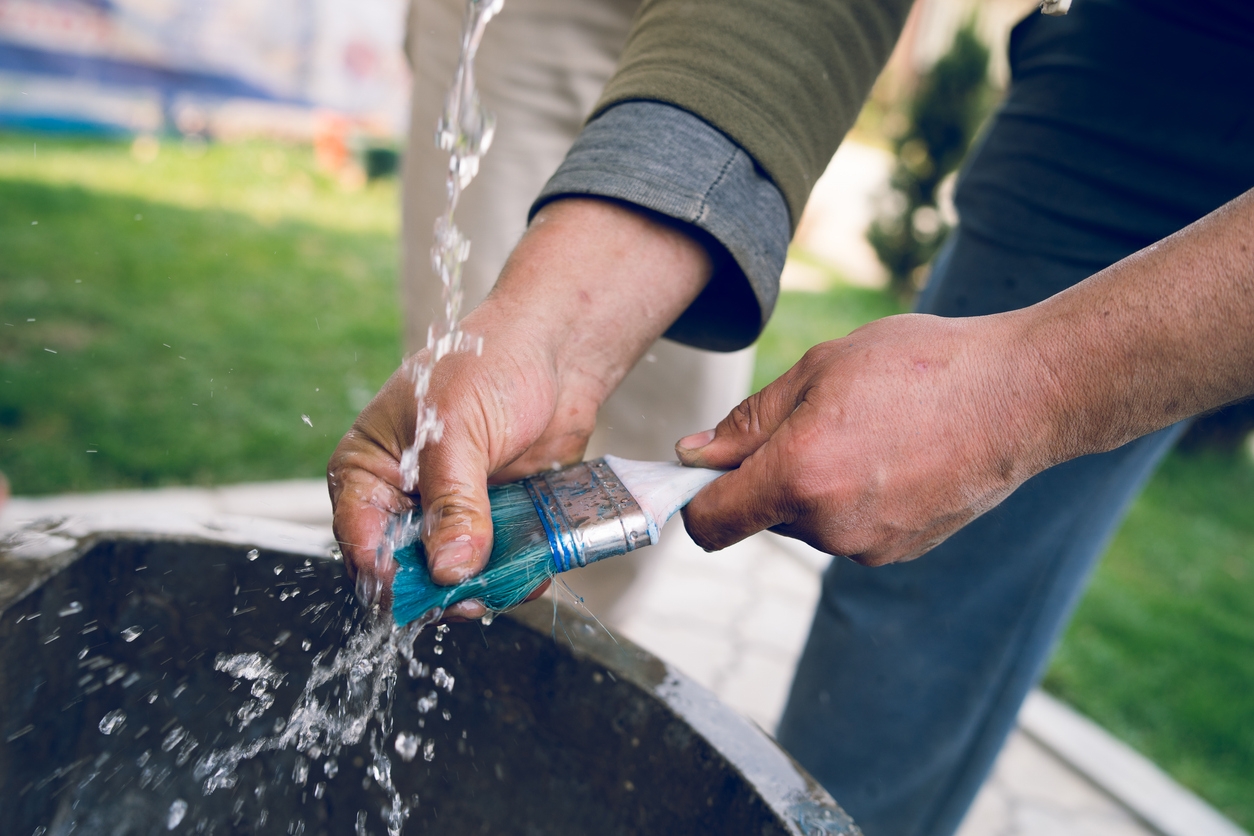Whether you’re a DIY home enthusiast or a professional painter, you know that paintbrushes need proper and regular care to extend their useful life. One of the ways to maintain paintbrushes is to clean and store them correctly after use.
Proper paintbrush storage is crucial in professional painting to maintain the quality and longevity of tools. Improper storage can lead to common issues like hardened bristles, loss of brush shape, and contamination, all of which can compromise a project’s finish and increase costs due to frequent brush replacement.
Cleaning your paintbrushes
Cleaning brushes after different types of paint
1. Latex (water-based) paint:
- Step 1: Rinse in warm water: Immediately after use, rinse the brush under warm running water to remove most of the paint.
- Step 2: Use soap: Apply a mild soap or brush cleaner, working it into the bristles with your fingers or a brush comb to remove any remaining paint.
- Step 3: Rinse: Rinse the brush thoroughly under warm water until the water looks clear.
- Step 4: Spin dry: Shake or spin the brush to remove excess water.
- Step 5: Reshape and store: Reshape the bristles and store the brush flat or hanging to dry.
2. Oil-based paint:
- Step 1: Wipe excess paint: Use a rag or paper towel to wipe off as much paint as possible.
- Step 2: Soak in solvent: Soak the brush in a suitable solvent (like mineral spirits or paint thinner) in a well-ventilated area. Swirl the brush in the solvent to loosen the paint.
- Step 3: Comb and soak again: Use a brush comb to remove any remaining paint from the bristles, then immerse again in clean solvent.
- Step 4: Rinse with soap and water: Wash the brush with soap and warm water to remove any remaining solvent.
- Step 5: Dry and store: Shake off excess water, reshape the bristles, and store the brush flat or hanging.
Importance of thorough cleaning to maintain brush quality
Thorough cleaning is crucial for maintaining brush quality, whether in-house or commercial painting. Residual paint, especially from oil-based products, can harden the bristles, making the brush stiff and less effective for future use. Proper cleaning also prevents cross-contamination of colors and types of paint, ensuring the best finish on subsequent projects. Regular and thorough cleaning extends the lifespan of the brushes, ultimately saving money and ensuring consistently high-quality results in your painting work.
Choosing the right storage location
Storing paintbrushes correctly is the key to maintaining their quality and longevity:
Ideal environmental conditions:
- Temperature: Keep brushes in a cool, stable environment. Extreme heat can cause the bristles to warp or the paint to dry out.
- Humidity: Maintain moderate humidity levels. Too much moisture can lead to rust on metal parts, while very dry conditions can cause bristles to become brittle.
Avoid:
- Direct sunlight: Sunlight can damage bristles and degrade the adhesive that holds them to the handle.
- Dust: Dust can settle on brushes, affecting their performance and cleanliness.
- Extreme temperatures: Both high and low temperatures can negatively impact the bristles and overall condition of the brushes.
Storing brushes in a clean, dry place away from direct sunlight and maintaining stable temperature and humidity will help preserve their functionality and extend their lifespan.
Proper storage techniques
Proper paintbrush storage is crucial for maintaining the quality and longevity of the brushes. Here’s a brief overview:
Hanging vs. lying flat:
- Hanging brushes: In a professional environment, hanging brushes is often preferred. This method prevents bristle deformation and keeps the brush in its natural shape. It’s useful for large brushes and those used frequently.
- Lying flat: For home or less frequent use, lying brushes flat on a clean, dry surface can be effective. This method also prevents bristle distortion and keeps the brush from collecting dust or debris.
Protective covers, cases, and brush keepers:
- Protective covers: After cleaning, use brush covers or guards to maintain the shape of the bristles and protect them from dust and damage.
- Cases: Storing brushes in cases or toolboxes can prevent physical damage and keep them organized.
- Brush keepers: These items support the bristles and maintain their shape during storage. They’re useful for high-quality or expensive brushes.
Organizing by project type and frequency of use:
- By project type: Store brushes according to their use (e.g., trim brushes, wall brushes) so you can quickly find the right tool for the job.
- By frequency of use: Keep frequently used brushes in an easily accessible spot. Less frequently used brushes can be stored away yet protected to prevent damage.
Organizing and storing correctly brushes ensures they perform well and have a longer lifespan.
Long-term storage solutions
For long-term storage of paintbrushes, whether for home or commercial use, consider these tips:
Between large projects
- Clean thoroughly: Always clean brushes thoroughly after use. Use soap and water for latex paints or mineral spirits for oil-based paints. Remove all paint to prevent it from drying and damaging the bristles.
- Dry properly: Allow brushes to dry completely. Lay them flat or hang them with bristles pointing downward to maintain their shape and prevent the rusting of metal parts.
- Store upright or flat: Store brushes upright in a container or flat in a drawer, ensuring the bristles are not bent. Store them in a brush holder or wrap them in paper to protect the bristles for long-term storage.
Preventing damage and ensuring readiness
- Condition bristles: Periodically condition bristles with brush conditioner or a mixture of vinegar and water to keep them supple and prevent them from becoming brittle.
- Avoid extreme conditions: Store brushes in a cool, dry place away from direct sunlight and extreme temperatures, which can affect the bristles and handle.
- Check regularly: Inspect stored brushes for any signs of damage or deterioration. If bristles become bent or out of shape, gently reshape them while still damp.
- Use brush covers: For extra protection, consider using brush covers or caps to keep bristles clean and maintain their shape.
Following these practices ensures your paintbrushes remain in good condition and are ready for use when needed.
Common mistakes and how to avoid them
Following these practices can help maintain the performance and extend the life of your paintbrushes.
Common mistakes in paintbrush storage
- Not cleaning brushes properly: Paint left on brushes can harden and damage the bristles. This issue is common in both commercial and residential settings.
- Improper drying: Brushes put away before they have the chance to dry can develop mold or misshapen bristles.
- Storing brushes with paint on them: Leaving paint on brushes can cause bristles to become stiff and lose their shape.
- Storing brushes bristle-down: Placing brushes bristle-down can deform the bristles and affect their performance.
Tips to extend the lifespan of professional-grade brushes
- Clean thoroughly: Use the appropriate solvent (water for latex paint, mineral spirits for oil-based paints) to remove all paint from the brush. Rinse until the water runs clear.
- Dry properly: After cleaning, reshape the brush and let it dry flat or hang with the bristles pointing downward to maintain their shape.
- Store correctly: Store brushes in a dry place. Use a brush holder or lay them flat to keep bristles from bending or becoming deformed.
- Use brush combs: Periodically comb out paint residue or debris to keep bristles clean and separated.
Conclusion
Adopting good storage habits not only enhances professional efficiency but also extends the life of your brushes, ensuring consistent and high-quality results in your projects.
For expert advice and top-notch painting services, contact Custom Painting, Inc. today. Call us at 925-294-8062 or message us via our contact page. Our team looks forward to elevating your painting experience!



